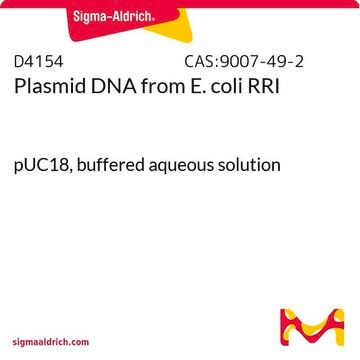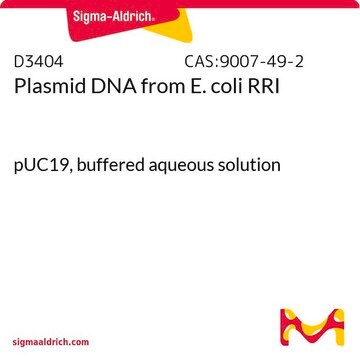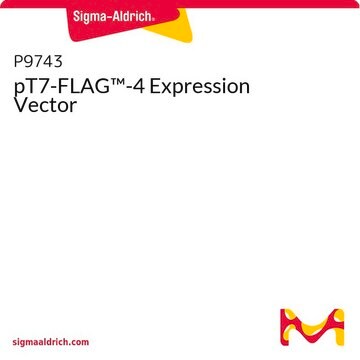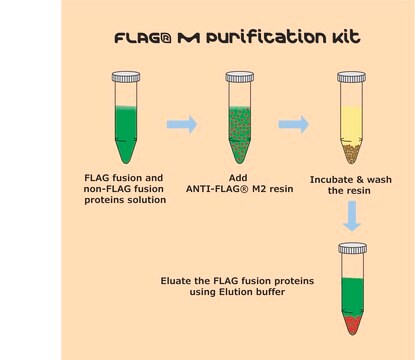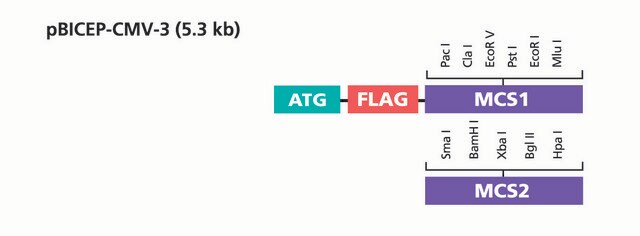E6783
pFLAG-CMV-3 Expression Vector
shuttle vector for transient or stable expression of N-terminal FLAG
Sign Into View Organizational & Contract Pricing
All Photos(2)
About This Item
UNSPSC Code:
12352200
Recommended Products
tag
FLAG® tagged
grade
Molecular Biology
form
buffered aqueous solution
Peptide tag location
N-terminal
shipped in
dry ice
storage temp.
−20°C
General description
The pFLAG-CMV™-3 Expression Vector is a 6.3 kb vector used for transient or stable expression in
mammalian cells. The vector is a derivative of pCMV5 used for transient or stable expression and secretion of a properly inserted open reading frame as an N-terminal FLAG fusion protein.
The pFLAG-CMV-3 Expression Vector is a shuttle vector containing both bacterial and SV40 origins of replication for propagation in both E. coli and mammalian cells. Efficiency of replication and genomic integration is optimal when using host cells that express the SV40 large T antigen.
The pFLAG-CMV-3-BAP Control Plasmid is a 7.7 kb derivative of pCMV51 used for transient expression and secretion of N-terminal FLAG bacterial alkaline phosphatase fusion protein in mammalian cells.
The FLAG® epitope is a small, hydrophilic 8 amino acid tag (DYKDDDDK) that provides for sensitive detection and high quality purification using ANTI-FLAG products available from Sigma-Aldrich.
Vector Maps and Sequences
mammalian cells. The vector is a derivative of pCMV5 used for transient or stable expression and secretion of a properly inserted open reading frame as an N-terminal FLAG fusion protein.
The pFLAG-CMV-3 Expression Vector is a shuttle vector containing both bacterial and SV40 origins of replication for propagation in both E. coli and mammalian cells. Efficiency of replication and genomic integration is optimal when using host cells that express the SV40 large T antigen.
The pFLAG-CMV-3-BAP Control Plasmid is a 7.7 kb derivative of pCMV51 used for transient expression and secretion of N-terminal FLAG bacterial alkaline phosphatase fusion protein in mammalian cells.
The FLAG® epitope is a small, hydrophilic 8 amino acid tag (DYKDDDDK) that provides for sensitive detection and high quality purification using ANTI-FLAG products available from Sigma-Aldrich.
Vector Maps and Sequences
Application
pFLAG-CMV™-3 Expression Vector is suitable for transient or stable expression and secretion of N-terminal FLAG-tagged fusion proteins in mammalian cells.
Components
- pFLAG-CMV™-3 Expression Vector 20 μg (E8770) is supplied as 0.5 mg/ml in 10 mM Tris-HCl (pH 8.0) with 1 mM EDTA.
- pFLAG-CMV™-3-BAP Control Plasmid 20 μg (C3972) is supplied as 0.5 mg/ml in 10 mM Tris-HCl (pH 8.0) with 1 mM EDTA.
Principle
The promoter-regulatory region of the human cytomegalovirus drives transcription of FLAG-fusion constructs. The preprotrypsin leader sequence precedes the FLAG® sequence and directs secretion of the fusion protein into the culture medium. The aminoglycoside phosphotransferase II gene (neo-r) confers resistance to aminoglycosides such as G 418, allowing for selection of stable transfectants.
Legal Information
FLAG is a registered trademark of Merck KGaA, Darmstadt, Germany
pFLAG-CMV is a trademark of Sigma-Aldrich Co. LLC
related product
Storage Class Code
10 - Combustible liquids
Choose from one of the most recent versions:
Certificates of Analysis (COA)
Lot/Batch Number
It looks like we've run into a problem, but you can still download Certificates of Analysis from our Documents section.
If you need assistance, please contact Customer Support.
Already Own This Product?
Find documentation for the products that you have recently purchased in the Document Library.
Koichi Ushizawa et al.
PloS one, 4(6), e5814-e5814 (2009-06-09)
Ly-6 superfamily members have a conserved Ly-6 domain that is defined by a distinct disulfide bonding pattern between eight or ten cysteine residues. These members are divided into membrane-type and secretory-type proteins. In the present study, we report the identification
Ahmet Sinan Sari et al.
Turkish journal of biology = Turk biyoloji dergisi, 45(3), 301-313 (2021-08-12)
Selective targeting of transfected mesenchymal stem cells (MSCs) carrying specific antioncogenes to the tumor was suggested as a treatment option. Bone morphogenetic protein-2 (BMP2) was shown to inhibit the proliferation and aggressiveness of osteosarcoma (OS) cells. Here, we aimed to
Chenyun Wang et al.
Journal of Huazhong University of Science and Technology. Medical sciences = Hua zhong ke ji da xue xue bao. Yi xue Ying De wen ban = Huazhong keji daxue xuebao. Yixue Yingdewen ban, 32(2), 299-302 (2012-04-25)
Many researchers employed mammalian expression system to artificially express cannabinoid receptors, but immunoblot data that directly prove efficient protein expression can hardly be seen in related research reports. In present study, we demonstrated cannabinoid receptor protein was not able to
Raogo Ouedraogo et al.
Diabetes, 55(6), 1840-1846 (2006-05-30)
Adiponectin is an abundant adipocyte-derived plasma protein with antiatherosclerotic effects. Vascular signal transduction by adiponectin is poorly understood and may involve 5'-AMP-activated protein kinase (AMPK), cAMP signaling, and other pathways. Hyperglycemia sharply increases the production of reactive oxygen species (ROS)
Jamila Gupte et al.
Proceedings of the National Academy of Sciences of the United States of America, 101(6), 1508-1513 (2004-02-06)
The identification of endogenous or surrogate ligands for orphan G protein-coupled receptors (GPCRs) represents one of the most important tasks in GPCR biology and pharmacology. The challenge lies in choosing an appropriate assay in the absence of ways to activate
Our team of scientists has experience in all areas of research including Life Science, Material Science, Chemical Synthesis, Chromatography, Analytical and many others.
Contact Technical Service
